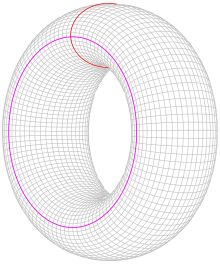Baer-Epstein's theorem
In mathematics , Baer-Epstein's theorem is a fundamental theorem in the topology of surfaces . It says that homotopic curves on surfaces are even isotopic, and that homotopic homeomorphisms of surfaces are always isotopic. It is named after Reinhold Baer and David Epstein .
Curves on surfaces
A simple closed curve on a surface is an embedding . Two curves
are called homotop if there is a continuous figure
with there. Two simple closed curves are called isotopes if there is a homotopy in which the curve is common to all
is a simple closed curve (i.e. an embedding).
Baer proved in 1928 that two homotopic, simple closed curves must also be isotopic on a closed , orientable surface. This theorem was generalized by Epstein in 1966 to non-compact surfaces with non-empty margins; the most general possible formulation is the following.
Proposition : Let be any surface, let
two base point-preserving homotopic embeddings, with neither an embedded circular disc nor an embedded Möbius strip in the edges. Then there is a base point preserving isotope with a compact carrier between and .
Homeomorphisms of surfaces
A homeomorphism is a continuous bijection with continuous inverse mapping . Two pictures
are called homotop if there is a continuous figure
with there.
Two homeomorphisms are called isotopic if there is a homotopy in which the mapping for all
is a homeomorphism.
Baer and Epstein used their results on curves on surfaces to prove the following equivalence of homotopy and isotopy for homeomorphisms of surfaces.
Proposition : Let be a surface with compact boundary, let
two homotopic homeomorphisms. (If the open or closed circular disk or the open or closed circular ring is, additionally assume that and either both are orientation-preserving or both are not orientation-preserving.) Then and are isotopic.
literature
- Reinhold Baer : Isotopy of curves on orientable, closed surfaces and their connection with the topological deformation of the surfaces. In: Journal for pure and applied mathematics . Vol. 159, 1928, pp. 101-116, ( digitized version ).
- David BA Epstein : Curves on 2-manifolds and isotopies. In: Acta Mathematica . Vol. 115, 1966, pp. 83-107 ( online ).
- Andrew J. Casson , Steven A. Bleiler: Automorphisms of Surfaces after Nielsen and Thurston (= London Mathematical Society Student Texts. 9) Cambridge University Press, Cambridge et al. 1988, ISBN 0-521-34203-1 .
Web links
- Cantwell-Conlon: Hyperbolic geometry and homotopic homeomorphisms of surfaces




![H \ colon S ^ {1} \ times \ left [0,1 \ right] \ to F](https://wikimedia.org/api/rest_v1/media/math/render/svg/3040dbd037d45621ed4d2a295934b518d41fb0c5)


![t \ in \ left [0,1 \ right]](https://wikimedia.org/api/rest_v1/media/math/render/svg/4fd270c3bd356bcd89e081db8a147db4ac9552d8)





![H \ colon F \ times \ left [0,1 \ right] \ to F](https://wikimedia.org/api/rest_v1/media/math/render/svg/28b049c383a88217f0395ef7883a521f7f1cf626)




